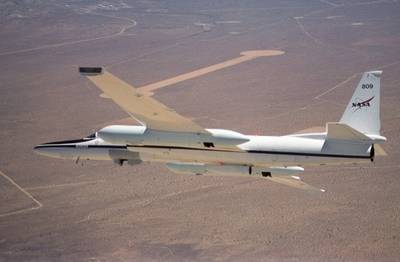Sat, Jul 16, 2005
Nasa's Tropical Cloud Systems And Processes Mission In Costa
Rica
 In the wake of Hurricane Dennis,
NASA and the National Oceanic and Atmospheric Administration (NOAA)
are busy studying data gathered during the early days of the
hurricane that threatened much of the southern Atlantic and Gulf of
Mexico.
In the wake of Hurricane Dennis,
NASA and the National Oceanic and Atmospheric Administration (NOAA)
are busy studying data gathered during the early days of the
hurricane that threatened much of the southern Atlantic and Gulf of
Mexico.
Researchers conducted their second coordinated flight to study
Tropical Storm Dennis on the evening of July 6. The ER-2 overflew
the developing eye and "rain bands" of the tropical storm using
coordinates relayed by the TCSP science team monitoring satellite
imagery on the ground. The ER-2, which flew at 65,000 feet, was
joined a few hours later by the NOAA P-3 Orion, flying at 14,000
feet. During the mission, the National Hurricane Center upgraded
Tropical Storm Dennis to Hurricane Dennis at Category 1
intensity.
The NASA and NOAA planes flew coordinated passes over the eye of
the storm for more than an hour. Both aircraft monitored
precipitation structures as the eye became more tightly concentric,
and rain bands increased in intensity with each pass. The P-3 Orion
continued to monitor the storm's eye wall and rain band development
for several more hours after the ER-2 returned to base, making five
passes over the eye. At one point, the storm pressure dropped 12
millibars in a two-hour period -- equivalent to the amount that a
garden-variety low pressure system over the United States may
intensify in about 24 hours.
The TCSP missions to document developing tropical cyclones are
providing rare datasets that will help unravel the mysteries about
why so few tropical weather disturbances intensify into
full-fledged hurricanes. For instance, "rapid deepening" -- a
phenomenon in which the minimum sea-level pressure of a tropical
cyclone drops by 1.75 millibars per hour, or 42 millibars in 24
hours -- is still poorly understood and is not captured well by
hurricane forecast models. In the case of Dennis, the data captured
exceptionally rapid deepening of the storm's central pressure, as
well as documenting the eye in the process of closing off into a
complete circle.

The 28-day TCSP mission is sponsored by NASA's Science Mission
Directorate at NASA Headquarters in Washington. The primary goal of
the mission is to document "cyclogenesis" in action -- the
interaction of temperature, humidity, precipitation, wind and air
pressure that creates ideal birthing conditions for tropical
storms, hurricanes and related phenomena.
More News
Have A Story That NEEDS To Be Featured On Aero-News? Here’s How To Submit A Story To Our Team Some of the greatest new stories ANN has ever covered have been submitted by our>[...]
“The legislation now includes a task force with industry representation ensuring that we have a seat at the table and our voice will be heard as conversations about the futur>[...]
Aero Linx: Waco Museum The WACO Historical Society, in addition to preserving aviation's past, is also dedicated and actively works to nurture aviation's future through its Learnin>[...]
Adcock Range National low-frequency radio navigation system (c.1930-c.1950) replaced by an omnirange (VOR) system. It consisted of four segmented quadrants broadcasting Morse Code >[...]
Also: uAvionix AV-Link, Does Simming Make Better Pilots?, World Games, AMA National Fun Fly Czech sportplane manufacturer Direct Fly has finished delivering its 200th ALTO NG, the >[...]
 ANN FAQ: Submit a News Story!
ANN FAQ: Submit a News Story! Aero-News: Quote of the Day (06.12.24)
Aero-News: Quote of the Day (06.12.24) ANN's Daily Aero-Linx (06.12.24)
ANN's Daily Aero-Linx (06.12.24) ANN's Daily Aero-Term (06.12.24): Adcock Range
ANN's Daily Aero-Term (06.12.24): Adcock Range Airborne Affordable Flyers 06.06.24: 200th ALTO, Rotax SB, Risen 916iSV
Airborne Affordable Flyers 06.06.24: 200th ALTO, Rotax SB, Risen 916iSV




